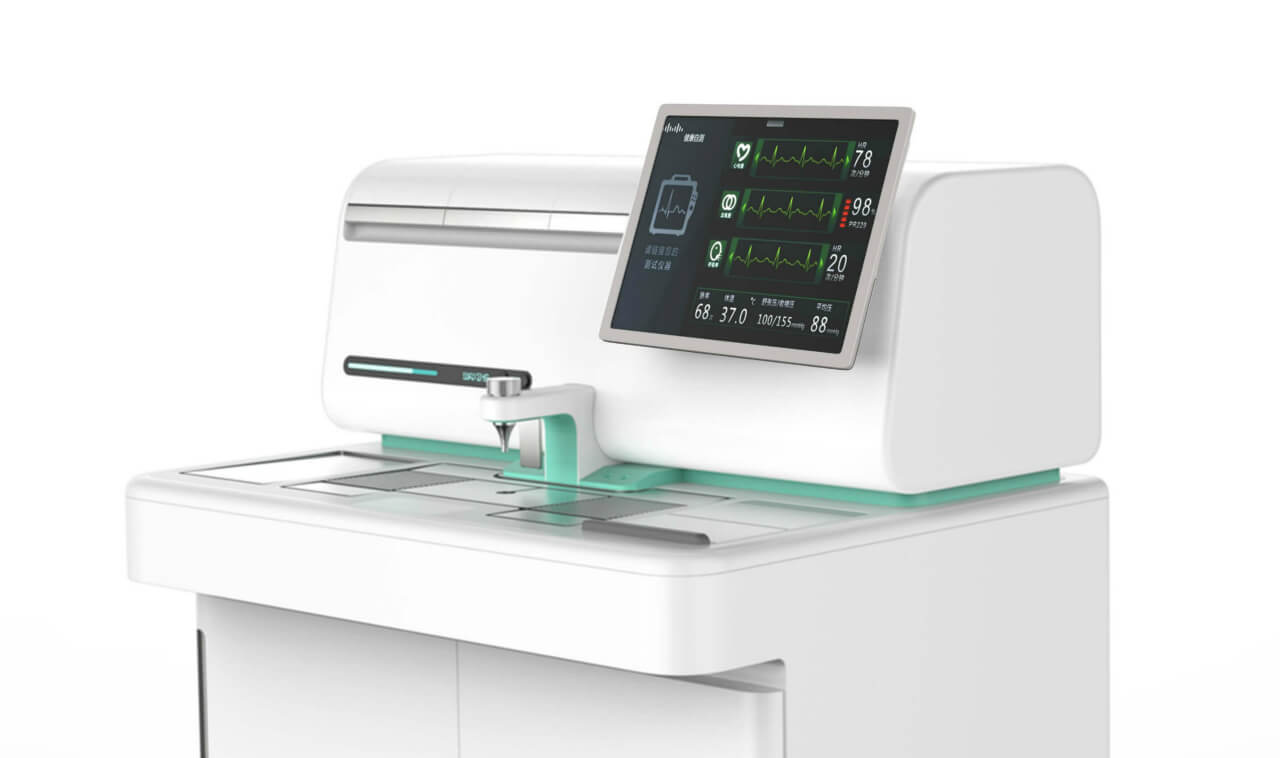Something about medical monitor
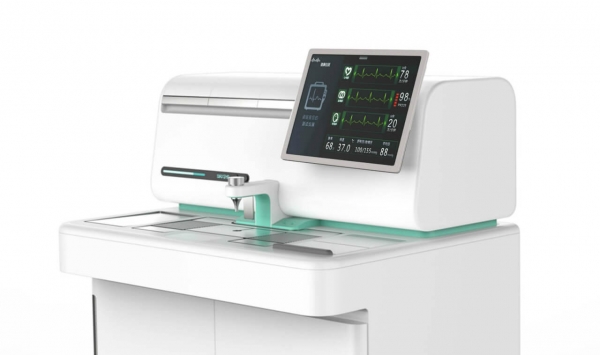
The global spread of COVID-19 has led to strong demand for medical monitor products. This article introduces the characteristics of medical display products and the differences from ordinary displays.
A liquid crystal display, or LCD (Liquid Crystal Display), is a flat and ultra-thin display device. Its main principle is that the current stimulates liquid crystal molecules to produce points, lines, and surfaces to cooperate with the backlight to form a picture. With the increasing maturity and popularity of PACS technology, and the rapid development of a variety of digital imaging equipment, such as DR, CR, multi-row CT, 3D images, and so on, the selection and configuration of medical displays have become the focus of hospitals and PACS integrators.
The medical monitor is the final presenter of the medical image in the digital system, it needs to replace traditional film, ensure image quality, and finally realize the observation and diagnosis of patients by doctor’s “soft reading film”.
In the PACS system, all medical displays are required to have consistency and integrity.
In the PACS system, all medical displays are required to have consistency and integrity.
1. Compliant with DICOM PART14
DICOM is the abbreviation of Digital Imaging and Communications in Medicine, which is the standard for digital imaging and communication in medicine. Manufacturers of medical imaging equipment (NEMA) established this standard with potential users of the DICOM standard (ACR). The DICOM standard defines the composition format and exchange method of images and related information so that people can establish an interface on the imaging equipment to complete the input/output of image data. DICOM PART14 is a standard for grayscale image display. The medical monitor must have the ability to adjust the DICOM standard curve to match the DICOM standard, so as to ensure the display quality of the image.
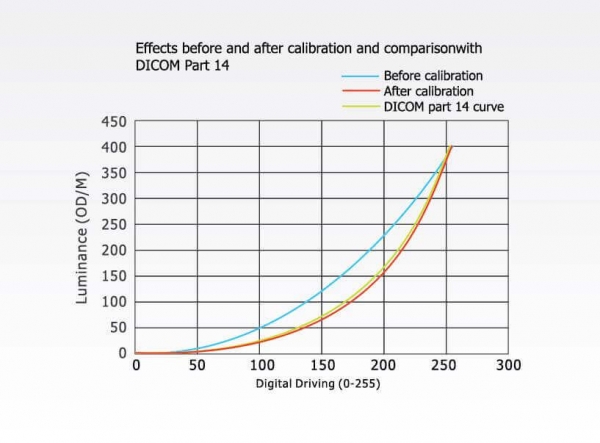
2.Support grayscale display
Grayscale refers to the level that the monitor can display from the brightest value to the darkest value. Grayscale is an important parameter for displaying patients’ lesions in real medical images. Only when there are enough levels of grayscale can high image quality be achieved. Ordinary displays have 8-bit-256 gray levels for displaying color images without gray-level requirements; medical displays have 10-bit-1024 gray levels for displaying X-ray gray-level images, which are relevant for diagnosis.
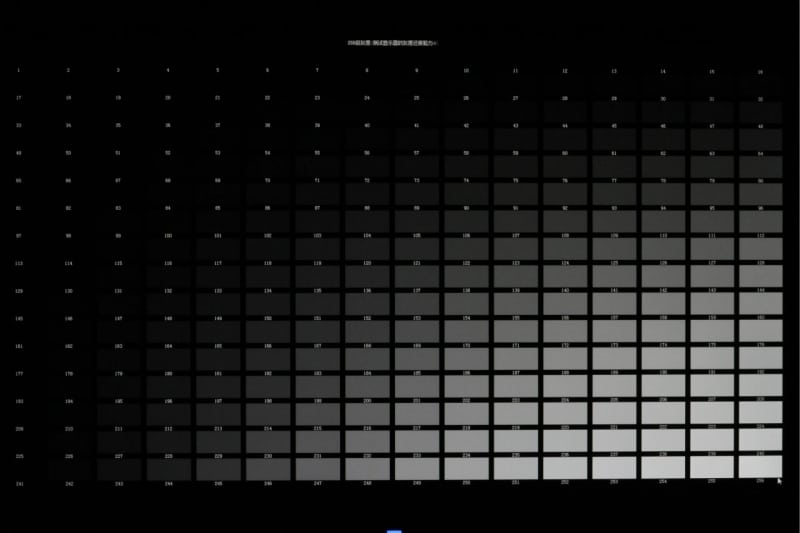
3. The backlight brightness can be stably controlled
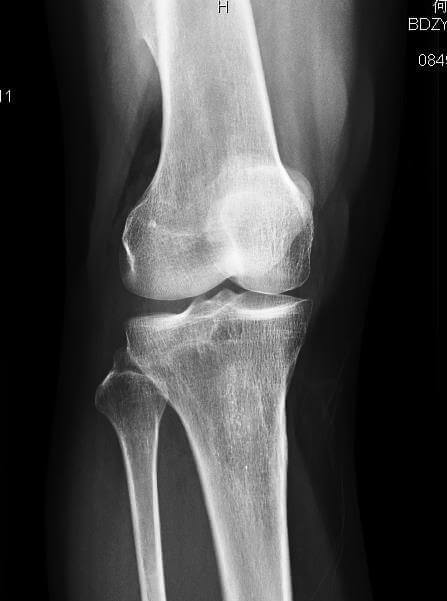 LCD brightness is measured in candelas per square meter (cd/m2), which is the maximum brightness that can be produced by the backlight tube light source. Because medical displays need high gray levels to express medical radiological images, high brightness correspondingly enlarges the gray levels between the darkest and the whitest, providing doctors with a gray-scale effect equivalent to film. Ordinary display brightness is 200-300cd/m2, there is no requirement for constant brightness; while the medical display is 600-700 cd/m2, the brightness after calibration is set between 400-500 cd/m2, and the brightness value is required to maintain 30,000 hours or even 100,000 hours are unchanged.
LCD brightness is measured in candelas per square meter (cd/m2), which is the maximum brightness that can be produced by the backlight tube light source. Because medical displays need high gray levels to express medical radiological images, high brightness correspondingly enlarges the gray levels between the darkest and the whitest, providing doctors with a gray-scale effect equivalent to film. Ordinary display brightness is 200-300cd/m2, there is no requirement for constant brightness; while the medical display is 600-700 cd/m2, the brightness after calibration is set between 400-500 cd/m2, and the brightness value is required to maintain 30,000 hours or even 100,000 hours are unchanged.Constant brightness is important for medical displays to ensure that the display brightness does not change over time. Experimental research proves that the relationship between display brightness and naked eye sensitivity is: when the brightness is 500 cd/m2, the naked eye sensitivity is 700; when the brightness is 800 cd/m2, the naked eye sensitivity is 777 (the maximum). The ideal brightness needs to be set at 400~500 cd/m2 so that users will not feel tired.
4.Resolution
Resolution is the number of pixels actually displayed per unit area. The resolution of the common 4:3 ratio monitors is 1024 * 768, 1280 * 1024, and so on. Medical displays require high resolution, and the general resolution is above 1280 * 1024. The resolution of a medical display is directly proportional to the price and is directly related to the resolution of the radiation equipment. The corresponding equipment should be equipped with a corresponding LCD display.
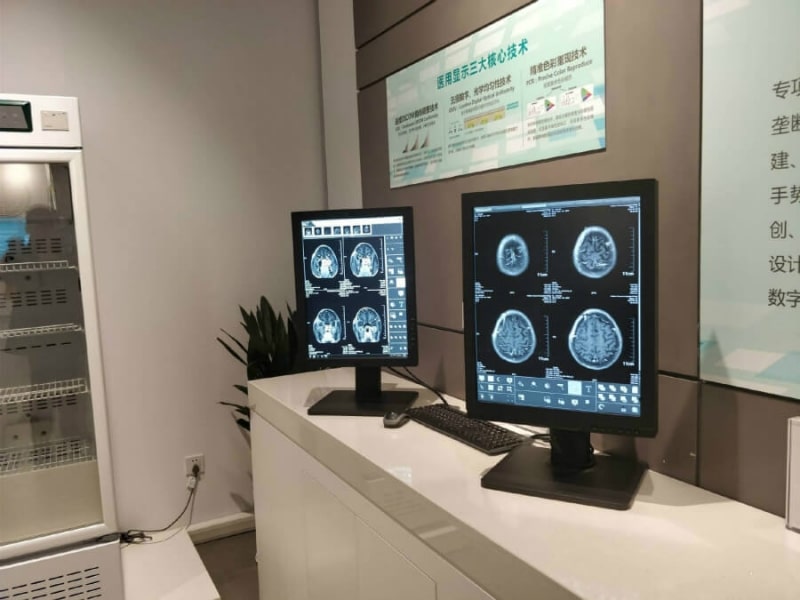
Resolution Units—Pixels
- 1K = 1024
- 1MP (one million pixels) = 1024 * 1280 (vertical screen) / 1280 * 1024 (horizontal screen) (1K * 1K)
It is commonly used in horizontal screen display, which is mostly suitable for CT, MRI and digital gastrointestinal machines.
- 2MP (two million pixels) = 1200 * 1600 (vertical screen) / 1600 * 1200 (horizontal screen) (1.5K * 1K)
It is commonly used in vertical screen display, which is most suitable for CR, DSA, digital gastrointestinal machines, and PACS film reading workstations.
- 3MP (three million pixels) = 1536 * 2048 (vertical screen) / 2048 * 1536 (horizontal screen) (2K * 1.5K)
It is commonly used in vertical screen display, mostly suitable for CCD-DR and PACS diagnostic workstations.
- 4MP (four million pixels) = 2560 * 1600 (2.5K * 1.5K)
- 5MP (five million pixels) = 2048 * 2560 (vertical screen) / 2560 * 2048 (horizontal screen) (2.5K * 2K)
It is commonly used in vertical screen display, mostly suitable for flat DR, breast machine and PACS diagnostic workstations.
- 9MP (nine million pixels) = 3840 * 2400 (3K * 3K)
5.Contrast
Contrast is the ratio of pure white brightness to pure black brightness of the screen. The higher the contrast, the clearer the image. The contrast ratio of ordinary displays is 300: 1 ~ 400: 1, and the contrast ratio of medical displays is 600: 1 ~ 1000: 1. However, when the contrast reaches a certain level, there will be problems with color purity. Only with the right combination of brightness and contrast can perfect graphics be presented. Generally, a medical monitor with a contrast of ≥600 will be better.
6, Response time
Response time refers to the speed at which each pixel reacts to the input signal, that is, the speed at which a pixel changes from dark to light or from light to dark, and its unit is milliseconds (ms).
There is a phenomenon of “visual residual” in the human eye, that is, the moving picture will form a short-term impression in the human brain. The acceptable display speed of the picture is generally 24 frames per second, which is also the origin of the movie’s 24 frames per second. If the display speed is lower than this standard, people will obviously feel uncomfortable and the picture pauses. Calculated according to this standard, each picture needs to be displayed for less than 40ms. CT, MRI, CR, and DR images are mostly static images, which do not place excessive demands on the response time; the response times of medical displays are 50ms, 35ms, and 25ms, and there is not much difference when viewing the images. However, when configuring systems that play dynamic images, such as cardiovascular machines and digital gastrointestinal machines, medical displays with response times below 25ms are preferred.
7. Certification
Ordinary displays have environmental and electromagnetic certifications. Medical displays not only have environmental protection and electromagnetic related certifications but more importantly, have medical industry certifications before they can enter the medical field and be recognized by law. Such as Europe CL certification and China CCC certification. 3C certification is Chinese compulsory product certification. Its English name is China Compulsory Certification, and its abbreviation is CCC. The full name of 3C certification is “China Compulsory Product Certification”. It is a product conformity assessment system implemented by the Chinese government to protect consumers’ personal safety and national security, strengthen product quality management, and comply with laws and regulations.
Because medical monitors are not managed as medical devices in mainland China, medical device registration certificates cannot be obtained.
8. Safety
Conventional displays have no LCD protection circuit, and the power supply is built-in and has no special requirements. In order to improve the safety of electrical and electromagnetic radiation, medical displays use external power adapters.
9.Graphics card
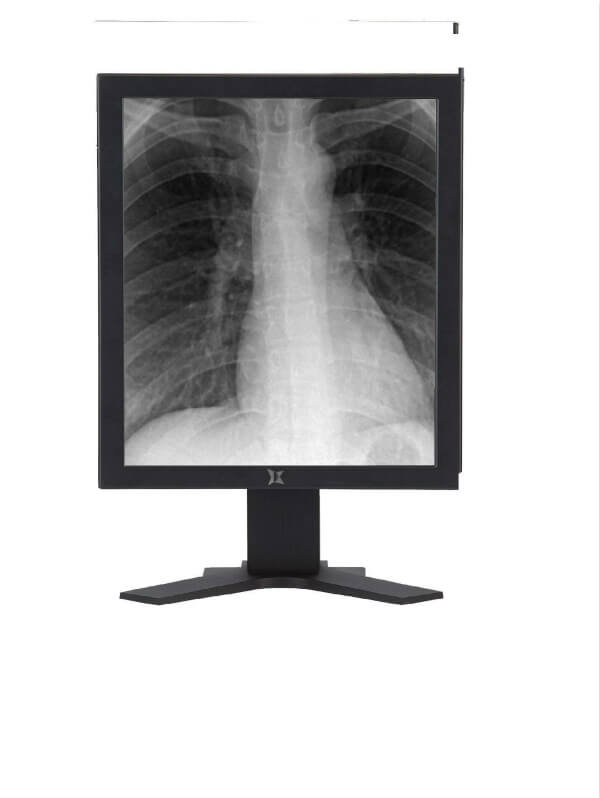 The graphics features of ordinary monitors include memory, speed, 3D indicators, and commonly used AGP slots; however, medical monitors often use PCI slots, which require one card and two displays, interchange of main and auxiliary displays, and horizontal/vertical screen conversion.
The graphics features of ordinary monitors include memory, speed, 3D indicators, and commonly used AGP slots; however, medical monitors often use PCI slots, which require one card and two displays, interchange of main and auxiliary displays, and horizontal/vertical screen conversion.(1) One card and two displays: When a workstation is equipped with two monitors, the graphics card has two output ports.
(2) The interchange between main and auxiliary display: When the workstation has a common monitor and one or more medical monitors at the same time, the common monitor and the medical monitor display color and grayscale images, respectively. Whether it is a medical display or an ordinary display as the main display, the color and grayscale are displayed normally.
(3) Horizontal/vertical screen conversion: Ordinary graphics cards only support horizontal screen display; medical special graphics cards have horizontal/vertical screen display settings. Generally, CT, MRI, DSA, and breast examinations are used for horizontal display, and CR and DR chest radiographs are used for portrait display.


